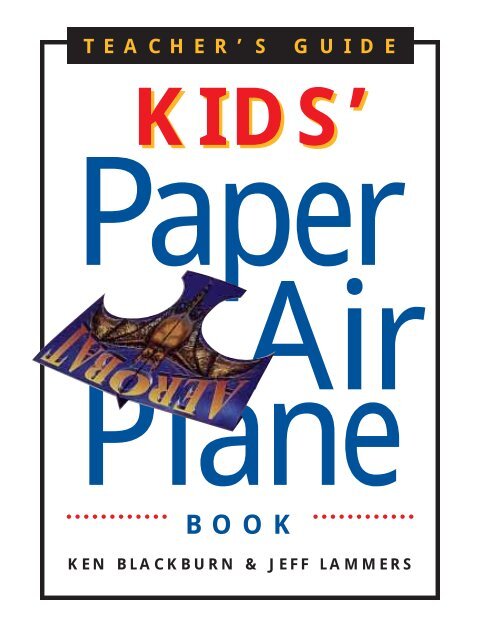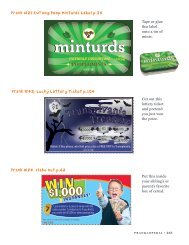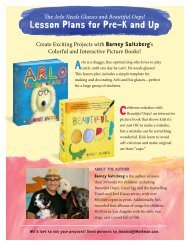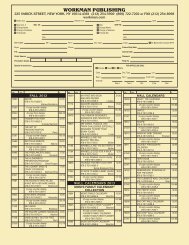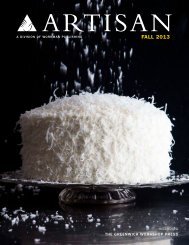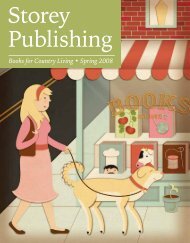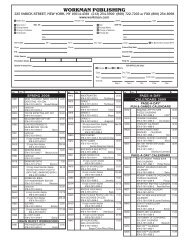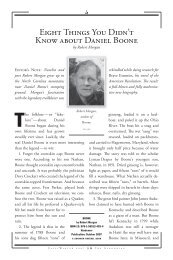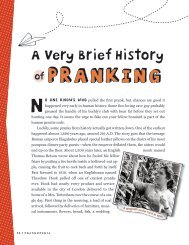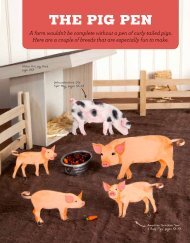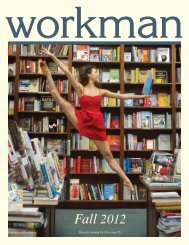World Record Paper Airplane Book Teachers' Guide - Workman ...
World Record Paper Airplane Book Teachers' Guide - Workman ...
World Record Paper Airplane Book Teachers' Guide - Workman ...
Create successful ePaper yourself
Turn your PDF publications into a flip-book with our unique Google optimized e-Paper software.
TEACHER’S GUIDE<br />
KIDS’<br />
<strong>Paper</strong><br />
Air<br />
Plane<br />
BOOK<br />
KEN BLACKBURN & JEFF LAMMERS
KIDS’<br />
PAPER AIRPLANE BOOK<br />
CONTENTS<br />
Introduction: How Do <strong>Airplane</strong>s Fly . . . . . . . . . . . . . . . . . . . . .2<br />
Curriculum-Based Activities . . . . . . . . . . . . . . . . . . . . . . . . . . .4<br />
Resources . . . . . . . . . . . . . . . . . . . . . . . . . . . . . . . . . . . . . . . . .9<br />
A NOTE TO TEACHERS<br />
Dear Teacher,<br />
Many years ago, I was that kid in the back of the classroom<br />
making paper airplanes. For me, paper airplanes<br />
brought science and aerodynamics to life and became<br />
the foundation for my current career as an aeronautical<br />
engineer at Boeing.<br />
This teacher’s guide to the Kids’ <strong>Paper</strong> <strong>Airplane</strong> <strong>Book</strong><br />
helps to explain the basic concepts of flight and shows<br />
how to incorporate hands-on flight-related activities into<br />
subjects across the curriculum. I hope this guide helps<br />
your students discover the fun and fascination in science<br />
that I experienced as a kid folding up sheets of paper.<br />
Happy Landings,<br />
Ken Blackburn
Introduction:<br />
How Do <strong>Airplane</strong>s Fly<br />
THE POWER OF AIR<br />
Flying is about harnessing the<br />
power of air. Air may be invisible<br />
and seem like “nothing.” But in<br />
fact, air is all around us, takes up<br />
space, and weighs quite a bit.The<br />
air that fills a bedroom weighs<br />
about 100 pounds.<br />
The weight of air bearing down<br />
on Earth creates the air pressure<br />
around us.We don’t feel the pressure<br />
of the air because the pressure<br />
is the same inside and outside our<br />
bodies.When we fly in an airplane<br />
(there is reduced air pressure as it<br />
climbs higher) or dive underwater<br />
(there is increased water pressure as<br />
you go deeper), we can feel the<br />
pressure change. Air pressure helps<br />
to drive the weather, and lets birds<br />
and airplanes fly.<br />
BERNOULLI’S PRINCIPLE<br />
Humans have marveled at the<br />
flight of soaring birds throughout<br />
history. H owe ve r , the journey to<br />
flight wa s n ’t truly started until a<br />
D u t c h - b o rn Swiss scientist made an<br />
i m p o rtant discove ry about air.<br />
In 1738 Daniel Bernoulli discovered<br />
that when air (or any other gas<br />
or liquid) speeds up, its pressure<br />
drops and vice versa.<br />
Bernoulli’s<br />
principle<br />
basically says that<br />
fast-moving air has less<br />
pressure than slowermoving<br />
air. This may<br />
not sound like<br />
much. However, it explains how<br />
wings in nature work and is the<br />
central principle behind the design<br />
of aircraft wings, hang gliders,<br />
Frisbees, and most other fliers.<br />
Think of the shape of a bird or<br />
airplane’s wing.The leading (front)<br />
edge of the wing is a little higher<br />
than the back edge. Because of this,<br />
as the wing travels through the air,<br />
the air rushing over the top of the<br />
wing speeds up and the air going<br />
below the wing slows down.<br />
Bernoulli’s principle says that<br />
faster air has less pressure, so the<br />
air zooming over the top of the<br />
wing drops in pressure and creates<br />
a suction, pulling the wing upward.<br />
Meanwhile, the air below the wing<br />
is moving slower, so it has more<br />
pressure, which means that it pushes<br />
up on the wing.The result is an<br />
upward force, called lift.<br />
Lift is the force that pulls an airplane<br />
off the gr o u n d .U n f o rt u n at e l y,<br />
gr avity pulls it back dow n . And while<br />
the engines thrust the plane forwa r d ,<br />
2
drag (air resistance) pulls it back.<br />
produce the needed lift.<br />
G r av i t y, l i f t ,t h ru s t , and drag are the<br />
four competing forces of fli g h t .<br />
FORWARD OR BACKWARD<br />
R<br />
Flying is a balancing act betwe e n<br />
ead the<br />
DRAG<br />
THE FOUR FORCES OF AERODYNAMICS<br />
AND THRUST<br />
Lift<br />
Drag<br />
section on<br />
pages 7 and 8<br />
of Kids’ <strong>Paper</strong><br />
<strong>Airplane</strong> <strong>Book</strong>.<br />
The forwardpushing<br />
force<br />
of thrust also<br />
plays a part in<br />
getting a plane<br />
or bird flying.<br />
Thrust<br />
A large, heavy<br />
Gravity<br />
plane uses the<br />
these forces.<br />
thrust from<br />
powerful engines to accelerate to a<br />
UP OR DOWN<br />
high speed.<br />
Read the GRAVITY AND LIFT<br />
Air flows faster and faster over the<br />
section on pages 6 and 7 of<br />
wings of the airplane as it speeds up<br />
Kids’ <strong>Paper</strong> <strong>Airplane</strong> <strong>Book</strong>.<br />
until enough lift is created for takeoff.The<br />
engines also keep the jet<br />
Remember that weight is a measure<br />
of the amount of gravity pulling<br />
moving forward once in the air so<br />
down on something. (Weight =<br />
the wings can continue to generate<br />
Gravity x Mass)<br />
sufficient lift.<br />
The amount of lift needed to<br />
Fighting against<br />
get a plane or bird off the gr o u n d<br />
thrust is drag. Drag<br />
depends on its we i g h t . A big plane<br />
is the air resistance<br />
needs more lift than a small plane<br />
slowing down the<br />
d o e s. O s t riches may have wings,<br />
airplane or bird.<br />
but they can’t fly. Their wings<br />
Engineers try to<br />
would have to be much bigger to<br />
reduce the<br />
3
amount of drag on an airplane<br />
through aerodynamic design.The<br />
shape of airplanes are streamlined<br />
and smooth to<br />
minimize air resistance, or drag.<br />
Engineers also try to keep aircraft<br />
as light as possible. Less weight<br />
means less lift is needed to reach<br />
and maintain flight.That’s why<br />
many birds have hollow bones—to<br />
lighten their load.<br />
Taming the four forces of flight<br />
may get a plane off the ground—<br />
but it won’t keep it there.A flier<br />
needs stability to keep the nose end<br />
going forward and the wings level.<br />
The Wright Brothers were the first<br />
to fly because they successfully created<br />
a stable aircraft. Read the WHY<br />
PAPER PLANES CRASH section on<br />
page 8 of Kids’ <strong>Paper</strong> <strong>Airplane</strong> <strong>Book</strong><br />
for more about stability.<br />
Cur riculum-Based<br />
Activities<br />
HANDS-ON PHYSICAL<br />
SCIENCE/MATH<br />
These experiments allow students<br />
to experience the four<br />
forces of flight using planes from<br />
Kids’ <strong>Paper</strong> <strong>Airplane</strong> <strong>Book</strong>. Also ask<br />
your students to do the activities<br />
demonstrating lift and drag on<br />
pages 7 and 8 of the book.<br />
Encourage students to make predictions,<br />
and careful observations, then<br />
draw conclusions. The extensions<br />
allow students to quantify their<br />
observations using math skills.<br />
■ Gravity Copters Have students<br />
take two Robo-Choppers each.<br />
Have them assemble one following<br />
the instructions on page 41 of Kids’<br />
<strong>Paper</strong> <strong>Airplane</strong> <strong>Book</strong> and have them<br />
crumple the other into a ball of paper.<br />
Have the students drop both<br />
from an equal height.What happens<br />
[The ball of paper falls faster<br />
and hits the ground first.] Why<br />
THE<br />
WORLD RECORD<br />
THROW<br />
4
[The Robo-Chopper generates lift,<br />
which balances gravity to allow it to<br />
descend slowly; the<br />
ball of paper does not<br />
produce lift, and gravity quickly<br />
pulls it to the ground.] Extension:<br />
Ask what would happen if this experiment<br />
were performed on the<br />
moon [Both would fall at the same<br />
rate, as there is no air for the Robo-<br />
Chopper to generate lift. Remind<br />
students that all objects fall at the<br />
same rate, no matter how heavy.<br />
Also, gravity on the Moon is onesixth<br />
that of Earth, so they would<br />
fall more slowly than on Earth.]<br />
FLYING FACT<br />
Leonardo da Vinci drew plans<br />
for a glider and a helicopter in the<br />
16th century.<br />
■ LIFT STRIP Have students cut<br />
out—but not assemble—a Dragon<br />
Ring as shown in step 1 on page 51<br />
in Kids’ <strong>Paper</strong> <strong>Airplane</strong> <strong>Book</strong>. Ask<br />
students to hold the narrow end of<br />
their strips to their lips and blow<br />
over the top of the paper. Ask what<br />
happens [The strip lifts up to flutter<br />
horizontally from the mouth.] Why<br />
[Bernoulli’s Principle—the air flowing<br />
over the downwardly curved<br />
paper speeds up and reduces pressure,<br />
creating lift. (Note:Younger<br />
students may need to cut along fold<br />
line 4 to make a lighter-weight<br />
strip.) Extension: Invite students to<br />
further experiment with lift by similarly<br />
blowing on the front of wings<br />
of assembled fliers from the book.<br />
Pirate’s Secret and The <strong>World</strong><br />
<strong>Record</strong> <strong>Paper</strong> <strong>Airplane</strong> work especially<br />
well.<br />
■ THUNDERBIRD THRUST Have<br />
students assemble two of the<br />
Thunderbird or Blue Angel planes<br />
according to the instructions on<br />
page 53 of Kids’ <strong>Paper</strong> <strong>Airplane</strong><br />
<strong>Book</strong>. Make sure both are flying<br />
equally well.The WHAT TO DO IF...<br />
box on page 52 will help solve flying<br />
problems. Invite students to<br />
launch both of their planes at the<br />
same time and in the same direction,<br />
one from each hand. Ask them<br />
to do this a number of times, noting<br />
which hand’s plane goes farther.<br />
Ask:Which plane gets more thrust<br />
or power [The one flown from the<br />
dominant hand.] What’s the result<br />
of more thrust [Longer flight<br />
and/or more lift.] Extension:<br />
Challenge students to measure the<br />
actual distances flown and calculate<br />
an average for their dominant and<br />
non-dominant hand.<br />
■ DRAGGING THUNDERBOLT<br />
Have students assemble the two<br />
Thunderbolt planes according to<br />
5
the instructions on page 49 of Kids’<br />
<strong>Paper</strong> <strong>Airplane</strong> <strong>Book</strong>. Making sure<br />
both are flying equally well, use the<br />
WHAT TO DO IF… box on page 48<br />
to solve flying problems. Next have<br />
students modify one of their planes,<br />
following these steps:<br />
a) Open up one of the planes flat so<br />
that fold line 1 is facing up.<br />
b) Draw a dashed line perpendicular<br />
to fold line 1 so it bisects the<br />
yellow 1.<br />
c) Cut along the pink-dotted fold<br />
lines 2 and 3 from the inside of<br />
the tail wings to the drawn<br />
dashed line.<br />
d) Fold these flaps up. Replace the<br />
paperclip on the nose.<br />
Now invite students to launch<br />
each airplane several times, noting<br />
how far each travels. Ask:Which<br />
plane flies farther [The unmodified<br />
one.] Why [It’s streamlined, or<br />
aerodynamic, shape cuts down on<br />
drag.The popped-up flaps on the<br />
modified plane work like brakes,<br />
slowing the plane down with air<br />
resistance or drag.] Extension:<br />
Challenge students to measure the<br />
actual distances flown and graph<br />
the results.<br />
LIFE SCIENCE<br />
■ ANIMAL FLIERS Students investigate<br />
animal flight using the animal<br />
theme planes in Kids’ <strong>Paper</strong> <strong>Airplane</strong><br />
<strong>Book</strong>. Have students choose and assemble<br />
either the Glider (p. 38),<br />
Aerobat (p. 42), or the Butterfly (p.<br />
46).Then invite them to find out<br />
fun facts about their animal flier.<br />
(Those who made the Glider can<br />
choose between an eagle, dragonfly,<br />
or pterosaur.) Challenge students to<br />
find out what their animal flier’s<br />
wings are made of, how far it can<br />
fly, and how flying helps it survive.<br />
Invite students to divide themselves<br />
into groups according to their chosen<br />
animal flier and put together a<br />
presentation to make to the rest of<br />
the class. Extension: Explore the<br />
world of other flying and gliding animals,<br />
such as flying squirrels, flying<br />
fish, mosquitoes, swallows, or hummingbirds.<br />
FLYING FACT<br />
Hummingbirds beat their wings<br />
22 to 78 times a second and can fly<br />
sideways, and backward, or hover<br />
like tiny helicopters.<br />
ART<br />
■ PLANE ART Students use the<br />
a i rplane pat t e rns in the K i d s ’ Pa p e r<br />
A i rplane <strong>Book</strong> as templates for creating<br />
their own fliers. I nvite students<br />
to choose a flier whose<br />
shape and design inspires them.<br />
Then have students trace the out-<br />
6
line of the pat t e rn—along with the<br />
numbered fold and cut lines—on<br />
the front side of the paper.T h e n<br />
h ave them flip the paper over and<br />
trace the reve rse side of the patt<br />
e rn onto the back of their tracing<br />
p a p e r. Next challenge students to<br />
assemble their fliers according to<br />
the particular instructions for<br />
e a c h . Then invite students to use<br />
c r ayo n s , p a i n t , g l u e , g l i t t e r , m a r k-<br />
e rs , and what e ver else they can<br />
think of to turn their flier into a<br />
work of art! (If your students are<br />
ve ry yo u n g, you might consider<br />
making a double-sided photocopiable<br />
tracing of one of the simpler<br />
designs yo u rself.) E x t e n s i o n :<br />
I nvite student groups to fashion a<br />
mobile out of their fliers. See page<br />
25 of K i d s ’ <strong>Paper</strong> A i rplane <strong>Book</strong>.<br />
FLYING FACT<br />
A 747 jumbo jet is longer than the<br />
distance flown during the Wright<br />
Brother’s first flight.<br />
BOEING 747<br />
SOCIAL STUDIES<br />
■ FLIER FACTS Students investigate<br />
real airplanes and rockets, using the<br />
planes in Kids’<strong>Paper</strong> <strong>Airplane</strong> <strong>Book</strong>.<br />
Have students choose and assemble<br />
either the Thunderbolt (p. 48), Blue<br />
Angel (p. 52),Thunderbird (p. 52),<br />
Saturn Rocket (p. 54),or F- 15 (p. 62).<br />
Have them read the information on<br />
their flier’s opposite page in Kids’<br />
<strong>Paper</strong> <strong>Airplane</strong> <strong>Book</strong> and then invite<br />
them to find out more about their<br />
plane or rocket (see Resources,<br />
page 9 in this guide). Consider creating<br />
a report page handout with<br />
such questions as:What is the length<br />
and weight When was the flier first<br />
built What was it used for Is it still<br />
used today Who flies it How much<br />
did/does it cost What was innovative<br />
about it Extension: Challenge<br />
the class to create a timeline of aircraft<br />
showing how aircraft design<br />
has evolved through the years.<br />
WRITING<br />
■ FIRST FLIGHT MINI-BOOKS<br />
Students write mini-books about<br />
the first powered flight. H ave students<br />
find out about the W ri g h t<br />
B r o t h e rs ’ f i rst flight at Kitty<br />
H aw k , N o rth Carolina, o n<br />
December 17, 1903 , using books,<br />
e n cy c l o p e d i a s , and multimedia<br />
(see Resources, page 9). Once the<br />
students are familiar with the<br />
s t o ry and the facts, i nvite them to<br />
7
w rite and illustrate mini-books<br />
about the eve n t .Younger students<br />
can draw simple picture books<br />
with a few wo r d s , while older students<br />
can use the mini-books as a<br />
f o rm at for report s , pasting in photocopied<br />
photogr a p h s.<br />
FLYING FACT<br />
A fear of heights is called<br />
acrophobia.<br />
LITERATURE<br />
■ FEAR OF FLYING Read The Sky<br />
of Now by Chaim Potok as a class.<br />
It’s about a 10-year-old boy who<br />
overcomes his fear of heights by<br />
taking a flight lesson aboard his<br />
uncle’s glider. Assure students that<br />
everyone has fears, and invite students<br />
to name their own similar<br />
fears or phobias, like fear of dogs,<br />
closed spaces, heights, flying, or<br />
water, listing them on the board as<br />
they talk. Divide students into<br />
groups and assign each group one<br />
or two fears. Challenge each group<br />
to come up with ways to overcome<br />
the fears and then let students share<br />
their findings with the class.<br />
Extension: Invite students to learn<br />
and use the fun scientific names of<br />
fears or phobias, such as<br />
“acrophobia,” “hydrophobia,”<br />
“claustrophobia,” and the like.<br />
HEALTH<br />
■ Pilots in Training<br />
Students design a “pilots’<br />
training” exercise program<br />
and chart their own progress.<br />
Training to be a fighter pilot or<br />
astronaut includes being physically<br />
fit. Challenge students to think of a<br />
countable exercise they can do in<br />
the classroom—sit-ups, push-ups,<br />
jumping jacks, for example. Have<br />
each student do his or her exercise<br />
for two minutes, counting the number<br />
of repetitions completed. Ask<br />
students to write down their exercise,<br />
how many were completed in<br />
two minutes, and the date. Repeat<br />
the activity three times a week for<br />
several weeks, while encouraging<br />
students to “train” at home, too.<br />
After several weeks, invite students<br />
to share how they’ve progressed.<br />
Extension: Challenge students to<br />
make a line graph of their progress,<br />
plotting the number of repetitions<br />
against time.<br />
8
Resources<br />
<strong>Book</strong>s for Young Readers<br />
Baylor,Byrd. Hawk,I’m Your Brother.<br />
Scribner, 1976. (fiction)<br />
Evans,David and Claudette Williams.<br />
Air & Flying. Dorling Kindersley,<br />
1993.<br />
Gibbons, Gail. Flying. Holiday House,<br />
1986.<br />
Pearl, Lizzy. The Story of Flight.<br />
Troll Associates, 1994.<br />
Potok, Chaim. The Sky of Now.<br />
Knopf, 1995. (fiction)<br />
Taylor, Barbara. Up, Up & Away!:The<br />
Science Of Flight. Random House,<br />
1992.<br />
Walter, Mildred Pitts. Brother to the<br />
Wind. Lothrop, Lee & Shepard<br />
<strong>Book</strong>s,1985. (fiction)<br />
Williams, John. Projects With Flight.<br />
Gareth Stevens,1992.<br />
<strong>Book</strong>s for Experienced<br />
Readers<br />
Berliner, Don. Before the Wright<br />
Brothers. Lerner, 1990.<br />
Darling, David. Up, Up, and Away:The<br />
Science of Flight. Dillon Press, 1991.<br />
Gormley, Beatrice. Mail-Order Wings.<br />
Dutton, 1981. (fiction)<br />
Lantier-Sampon, Patricia. <strong>Airplane</strong>s.<br />
Gareth Stevens, 1994.<br />
Lopez,Donald. Flight. Time-Life<br />
<strong>Book</strong>s,1995.<br />
Moser, Barry. Fly!:A Brief History of<br />
Flight Illustrated. Willa Perlman<br />
<strong>Book</strong>s,1993.<br />
Parker, Steve. <strong>Airplane</strong>s. Copper Beech<br />
<strong>Book</strong>s, 1995.<br />
Weiss,Harvey. Strange and Wonderful<br />
Aircraft. Houghton Mifflin, 1995.<br />
Multimedia<br />
Daring to Fly!:From Icarus to the Red<br />
Baron. Arnowitz Studios; Maxis,<br />
1994. (CD ROM)<br />
Dreams of Flight. SunWest Media<br />
Group, 1993. (5-volume video set)<br />
Let Me Tell You All About Planes.<br />
Traditional Images, 1994. (video)<br />
<strong>World</strong> of Flight. Microsoft Corp.,1995.<br />
(CD ROM)<br />
Internet<br />
The Aviation History On-Line Museum.<br />
www.aviation-history.com/<br />
Author Ken Blackburn’s Homepage.<br />
www.geocities.com/CapeCanaveral/<br />
1817/<br />
NASA’s Space Link Page.<br />
spacelink.nasa.gov/.index.html<br />
The National Aerospace Museum.<br />
www.nasm.edu/NASMhome.html<br />
9
Lift, Gravity, Aerodynamics,<br />
and Even Bernoulli’s Principle<br />
This guaranteed smooth lesson plan on the physics of flight<br />
brings together science, math, history and even important<br />
health lessons. Packed with curriculum-based activities, it’s a<br />
teacher’s guide that shows how paper airplanes can be a<br />
valuable addition to a classroom.<br />
This informative booklet was<br />
developed by children’s science<br />
writer Mary Kay Carson, a former<br />
editor of Scholastic’s Super Science<br />
Blue, and author Ken Blackburn.<br />
Kids’ <strong>Paper</strong><br />
<strong>Airplane</strong> <strong>Book</strong><br />
By Ken Blackburn<br />
& Jeff Lammers<br />
$12.95<br />
ISBN 0-7611-0478-X<br />
Also Available<br />
The <strong>World</strong> <strong>Record</strong> <strong>Paper</strong> <strong>Airplane</strong> <strong>Book</strong> By Ken Blackburn and Jeff Lammers<br />
$14.95 • ISBN 1-56305-631-3<br />
For more information on <strong>Workman</strong> Publishing,<br />
our children’s books and teacher’s guides, please write to;<br />
Educational Sales<br />
WORKMAN PUBLISHING<br />
708 Broadway • New York, NY 10003-9555<br />
http://www.workman.com<br />
© 1997 <strong>Workman</strong> Publishing Company, Inc.


